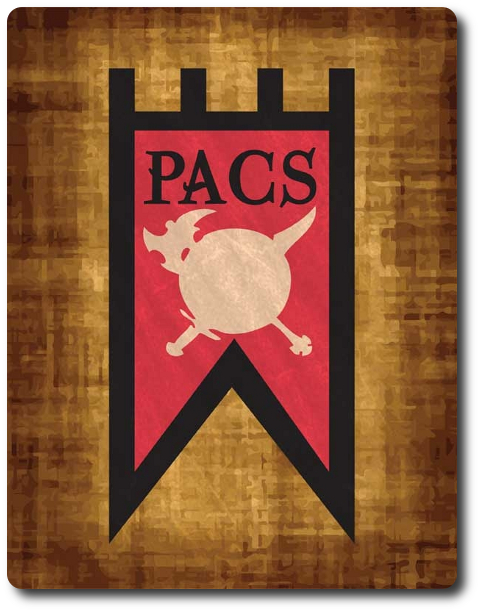
The Basics:
- For ages 8 and up (publisher suggests 10+)
- For 2 or more players
- Variable game play length
Geek Skills:
- Active Listening & Communication
- Counting & Math
- Logical & Critical Decision Making
- Reading
- Strategy & Tactics
- Risk vs. Reward
- Cooperative & Team Play
- Hand/Resource Management
- Self-confidence
- Imagination
Learning Curve:
- Child – Easy
- Adult – Easy
Theme & Narrative:
- Anything you care to imagine
Endorsements:
- Gamer Geek mixed!
- Parent Geek approved!
- Child Geek approved!
Overview
I have many fond memories of being a Child Geek and playing Dungeons & Dragons with my friends. Our role-playing games were little more than kicking down doors, killing all that moved, and looting everything to buy bigger and better gear. We loved it. But that was when I was a kid and had all the time in the world. As an adult, I am constantly scrambling to make time, find time, or be on time. But I still miss my days of exploring dungeons and beating up the bad guys. That’s why I’m so pleased to have found the Pocket Adventures Card System and a pocket to put it in.
Pocket Adventures Card System (PACS) Set II, a self-published role-playing game system designed by Benjamin Kanelos, is comprised of 8 Hero cards, 18 Loot cards, 28 Foe cards, 10 Class Specialization cards, 1 Dungeon Master Role card, and 7 Rules of Play cards. The entire game, including the rules, is printed on sturdy cards. There are no illustrations and what little imagery and color there is focuses on making it easy to spot statistical information. The majority of each card’s face is dedicated to descriptive text that further defines abilities, actions, reactions, and events that could occur during a playing session. Individuals with poor eyesight or in poor lighting will have difficulty reading the cards due to the smallness of print. Not included with the game, but easy to find, is at least 1 coin or 1 dice per player.
Note: I will not be teaching how to role-play in this review. If you are not familiar with role-playing games, take a moment to visit Learn Tabletop Roleplaying Games. The website does a good job of summarizing and introducing the most basic of concepts to the more complex. The best way to learn role-playing games is with an experienced player, in my opinion, as there are a lot of subtleties that cannot be taught so much as learned through game play.
Adventures in Your Back Pocket
PACS Set II was designed to be portable. All that is needed to play is a large enough area to place a few cards, a coin or three, and the time to enjoy a creative adventure. There is no world setting with PACS, but the Foe cards depict villains and monsters most commonly found in fantasy game settings. Since this is a role-playing game, there are no rules that cannot be bent, broken, or flat-out ignored if the Dungeon Master so decides.
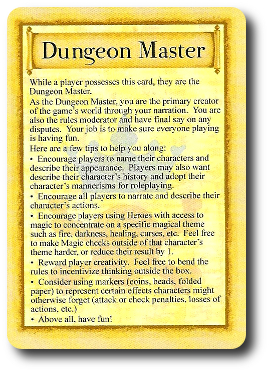
The Dungeon Master Role card is a special Hero card. It’s given to the player who will be leading the game’s narrative for the playing session and controlling the bad guys. The Dungeon Master Role card was designed to be passed around, allowing each player to share in the creation of the adventure, not just playing within it. There is nothing stopping players from permanently assigning the Dungeon Master Role card to one player, however, which is a great way to keep the game’s narrative consistent, if not coherent. The Dungeon Master Role card contains a brief description of the Dungeon Master’s responsibilities and suggestions on how to run a good game. This card can be set in front of the player or placed back in the card box since it serves no other purpose in the game other than summarizing the role.
Gather Your Party
Once the Dungeon Master role has been assigned, the other players need to select their Hero. All heroes are found on the Hero cards, but not all Hero cards are playable heroes. Only those cards that list the 6 Aptitudes represent the different Hero classes. The provided Hero classes include the Warlock, the Shaman, the Warlord, the Monk, the Fighter, the Stargazer, the Assassin, the Priest, and the Psion. Each Hero class lists a small set of hero Abilities that are unique to the class.
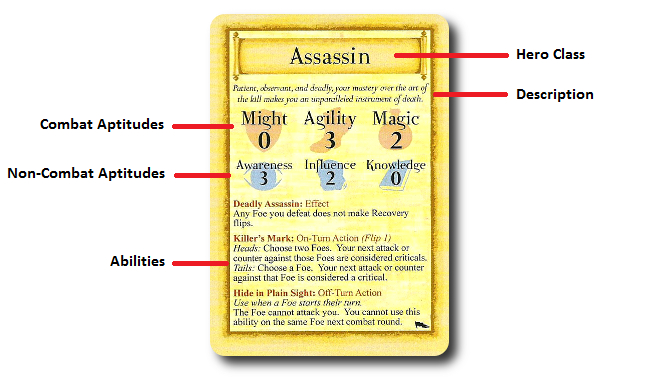
Aptitudes
There are 6 Aptitudes in total for the Heroes (and Foes). Three are specific to combat and the other 3 are focused more on non-combat Aptitude attributes. However, there is nothing stopping the Dungeon Master from using any of the 6 Aptitudes in, out, or never in combat. All 6 are summarized here.
- Might (combat): Measures the hero’s overall physical strength and endurance. Useful for climbing, lifting, jumping, and opening up stubborn jars of pickles.
- Ability (combat): Measures the hero’s overall dexterity and reaction time, including when a hero can take their actions during combat. Useful for sneaking, countering attacks, disarming traps, and avoiding slaps from insulted tavern wenches.
- Magic (combat): Measures the hero’s magical ability and training. Useful for casting spells, sensing magic, and pulling rabbits out of hats.
- Awareness (non-combat): Measures the hero’s ability to perceive the world around them, consciously or unconsciously. Useful for finding lost keys, sensing trouble, spotting the somewhat obscure, and identifying the third-wheel at a party.
- Influence (non-combat): Measures the hero’s presence and forcefulness of personality. Useful for intimidating others, bargaining, acting, and convincing significant others that a 72″ flat-screen TV is a “good investment”.
- Knowledge (non-combat): Measures the hero’s book smarts. How much they have read, learned, studied,and practiced before venturing out into the dangerous wilderness. Useful for recalling important facts like which mushrooms to eat, the approximate distance of towns from one another, and remembering the Pythagorean Theorem.
Again, and just like all role-playing games, the Dungeon Master gets to decide how the Aptitudes are used. However, the players also get a say and they can leverage their hero’s Aptitudes to influence and collect information in the game the way they want to. Role-playing games are a cooperative and creative experience, after all.
Abilities
The Hero’s Aptitudes give the players a lot of tools to work with, but remain somewhat generic. Each hero, regardless of their class can influence a Non-Player Character, for example. The uniqueness of each Hero class can be found in the Abilities. Warlocks can cast horrible curses, the Monk can dazzle an opponent with their martial art skills, and the Stargazer can see events occur seconds before they come to pass. Each Hero class lists the unique Ability of the specific hero, but it’s up to player to determine when best to use them.
Abilities are assigned an Action Type that defines when they can be used in combat. Abilities can be used out of combat per the instructions of the Dungeon Master.
- Effect: This Action Type is considered always “on and active”. The player doesn’t need to state they are specifically using this Ability, nor does it take an action to use it. Players just need to remember it’s there and on.
- On-Turn Action: This Action Type is triggered on a player’s turn and counts as their single action per turn.
- Off-Turn Action: This Action Type is triggered during another player’s turn and can only be used once per round.
Foes and Villains
PACS Set II comes with a lot of monsters to fight. For the most part, the Foe card is identical to the Hero card, complete with Aptitudes and Abilities. The only noticeable difference is the number value and icon next to the Foe name.
The number value is used when determining the Foe strength. Dungeon Masters can play multiple Foe cards to attack the Heroes, but the total strength of the Foe cards should not exceed the number of players if balance is a concern. For example, the “Vermin” Foe card has a strength of 1/2. If there are 3 players, the Dungeon master could use the “Vermin” Foe card and state that there are either 6 Vermin attacking or they could combine the “Vermin” Foe card with another Foe card. For example, with the “Foul Priest” Foe card that has a strength of 2. Combined, the total strength would be 2 1/2, which is still below the number of players in the game. These numbers provide guidance to the Dungeon Master when creating a balanced threat. A low strength total equals an easy challenge, while a higher strength indicates a much more dangerous encounter.
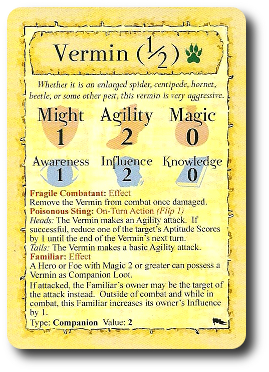
The icon next to the Foe name is meant to quickly classify the Foe card. For example, animal, demonic, or undead. The icons are used in two important ways. Some Abilities use the icons to help identify Foe cards for effects and they can also be used by the Dungeon Master to organize combat into meaningful groups.
The Dungeon Master can also “enhance” Foes by adding conditions to them. For example, the Dungeon Master can make the “Vermin” Foe card into an undead giant rat. Each condition Foe card will change the Aptitude values and provide additional abilities. It also makes the Foe more difficult, adding to the Foe card’s overall strength.
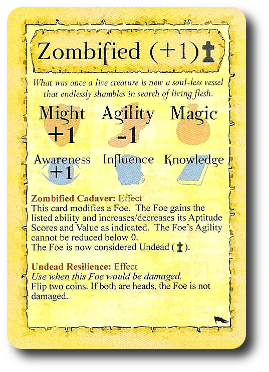
Each Foe card represents the stats for 1 enemy. The Dungeon Master can duplicate a specific Foe card by placing any number of Foe cards face-down next to it. These face-down Foe cards have the same stats as the face-up Foe card and can be targeted by the players. The Dungeon Master just needs to keep in mind that each face-down Foe card increases the overall total strength of the enemy forces they are commanding.
Non-Combat and Brutal Warfare
Eventually the Heroes will bump into a challenge placed there by the Dungeon Master. There are two types of challenges the players will need to overcome that require luck to help decide the outcomes.
Note: The game can be played with coins or dice. Whenever you see a reference to flipping coins and counting the “Heads” results, you can replace this by counting only positive or only negative numbers on a die. I suggest a six-sided die, but any die will do. Doesn’t matter as long as you can roll, flip, or toss it at least 3 times for a Boolean result.
Non-Combat Checks
An adventure’s life is not always full of dodging sword blows or hiding from dragons (although there really is a lot of both). There will be times when the player wants their hero to perform some task that the Dungeon Master will determine has some degree of risk of failure. The Dungeon Master will first tell the player which Aptitude will be used and the Difficulty Value they must overcome. This is commonly referred to as the Aptitude Check and the player must beat it to succeed.
The Difficulty Value will range from 1 (incredibly simple) to 6 (nearly impossible). The player flips 3 coins (or flips 1 coin three times) and counts the “Heads” results. This number is added to the Hero’s Aptitude value being used. If the total is equal to or higher than the Difficult Value, the Hero has successfully passed the Aptitude Check.
Combat Checks
Combat is a bit more involved than a non-combat check for two important reasons. First, timing is an issue. Who swings first often determines who gets hit first. Second, the players will want to work together and will need to change their tactics as the combat ensues.
When it comes to range, it’s always assumed that the Heroes and Foes are close enough to each other to do some damage. No range modifier or half-moves here. Just pick your target, attack, and hope for the best. When you can attack is determined by the Agility Aptitude value, unless the Dungeon Master says otherwise. The Hero with the highest Agility score goes first and then the Foe with the highest Agility score. Then back to the Heroes. This continues until all the Heroes and Foes have had an opportunity to attack or use an Ability. This is referred to as a round.
On a Hero’s or Foe’s turn, they can take 1 action. Actions are defined as major attempts to complete a specific task that have a high degree of failure under the pressure of combat. Opening doors, drawing weapons, and recalling specific bits of knowledge can be considered free actions by the Dungeon Master if they are determined to be simple enough to mentally or physically complete while being distracted. Everything else will cost the player 1 action to attempt.
Actions include any On-Turn Action listed on the Hero cards, a general Attack, or a non-specific action the Dungeon Master states will take the Hero’s action this turn to complete. Attacks are made by the attacker selecting a combat Aptitude and flipping the coin 3 times, adding the “Heads” values to the selected Aptitude value. The defending Foe (or Hero) must now flip 3 coins, combine the “Heads” values to the Aptitude value, and hope they get a result equal to or higher than the attacker. If they do, the attack fails. If not, damage is dealt.
Damage is tracked by rotating Foe and Hero cards. The first hit rotates the card by 45 degrees, which indicates injury. The second hit rotates the card another 45 degree, which indicates the Hero or Foe is defeated. Defeated Heroes and Foes cannot take actions during their turn except attempting to recover. To recover and rotate the card 45 degrees back to the injured position, flip 3 coins. If all 3 show a “Heads” result, the player can take an action on their next turn. If not, they can attempt to recover again on their next turn.
Regardless if damage is dealt or not, a Hero or Foe that is attacked may counter as a free action. Counter attacks are done in the same way as a normal attack, but the player who is countering now gets to decide on the Aptitude being used. A counter attack can only happen once (you cannot counter a counter attack).
Finally, as combat continues, it’s possible to do critical strikes and horrible fumbles. A critical strike occurs when all 3 coins flipped show a “Heads” result for an attack (or a check). Success is automatic, even if the combined total is less than the Difficulty Value. In contrast, A fumble occurs when all 3 coins flipped show a “Tails” result for an attack (or a check). Failure is automatic.
Combat continues until all the Heroes or Foes or defeated or run away (per the Dungeon Master’s decision). After combat, all Hero (and Foe) cards are returned to the fully healed card position.
Loot and Advancement
The Loot cards are awarded to the players whenever the Dungeon Master feels like it. There is no limit to the number of Loot cards a player can have during the game, but they are limited in how many they can use. Only 1 Loot card can be “equipped” at a time, but the player can swap out the Loot cards during the game as many times as they like. Players cannot not double up on Loot cards of the same type. Loot, while powerful, has limitations. Each Loot card has a type and value. These are useful for the Dungeon Master when determining their overall use and the general size of the reward being given to the players.

As far as normal weapons, armor, and spells go, nothing is provided. It’s up to the player to imagine what their Warlord is wearing and using in battle, what arcane magics their magic user is casting, and how sneaky their Assassin is in the shadows with their knives.
There are no Experience Points in PACS. Instead, the Dungeon Master determines when they think the player’s Heroes have accomplished enough to be taken to the next level. Leveling is through the use of the Class Specialization cards. These are attached to the Hero cards and provide additional Abilities and bonuses. When the Heroes have again obtained enough experience and done enough worldly deeds, the Dungeon Master can instruct the players to select another Class Specialization card. In this way, a player could create a “Shadow Stalking Assassin Weaponmaster” by combining multiple Class Specialization cards.
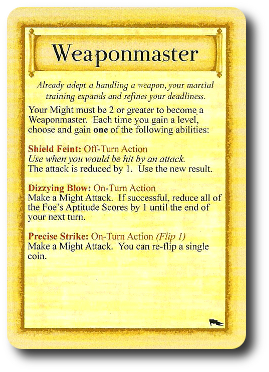
Combining Cards and Game Variants
The PACS Set II cards can be combined with the other PACS decks to provide even more options. Each deck is like a little source book that can add to the game world and story the players are creating. Everything a player needs to run a game is included in the PACS Set II, however. Owning multiple sets allows for further customization, mixing, and matching.
Several different methods of game play are provided. Each are summarized here.
Rotating DM
Share the burden (and fun) of being the Dungeon Master. At the start of each gaming session, a new Dungeon Master is selected. Or, if preferred, switch the role of Dungeon Master during specific intervals of the story.
Multiple Heroes
For smaller groups, have each player control 2 or more Hero cards at a time. This will increase the size of the adventuring party without demanding more players at the table. Works great when there are only 2 players available.
Play as the Foe
Change things up and let the players take on the role of the villains! Use the Foe cards and go fight hordes of goodly paladins, burn peasants, and tip defenseless cows.
Good Versus Bad
When there is no adventure to run, but blood is being called for, have the players draft Foes and throw them into the Thunderdome. Each player pits their Hero against another player’s Foe. When it’s all over, only one player will be able to brag about their combat abilities. Unfortunately, they’ll still be EXTREMELY awkward around the opposite sex.
To learn more about the Pocket Adventures Card System, visit the role-playing game’s web page.
Final Word
The Child Geeks found the rule system to be easy to grasp and fun to use. Splitting the Aptitudes into combat and non-combat types made it easy to introduce them one at a time without the need to juggling all the stats at once. They also understood the difference between on and off-action Abilities and effects thanks to the straightforward combat. According to one Child Geek, “This game is so easy! It’s easier than some of the board games we play, but twice as fun!” All but a very few of the Child Geeks were capable of flipping a coin and keeping it within arms reach of their seat. We substituted the coins with dice which the Child Geeks found to be easier to use and more fun to play with. A few of the Child Geeks tried their hand at Dungeon Master and did pretty well. When we consider that there are only a few more rules for the Dungeon Master to keep track of, taking control of the game’s narrative wasn’t that intimidating. Another Child Geek said, “What I like best about this game is that we can play it whenever we like.” Very true, but the game still has its limits. You still need a story and a quiet enough place to play it in so you aren’t shouting at each other. But the Child Geeks didn’t care about these minor details and gave PACS Set II two very enthusiastic thumbs way up in the air.

My little geek shows me his “war cry” as his fighter swings his mighty sword into the vermin swarm!
The Parent Geeks enjoyed how easy the rules were to learn and how portable the game was. According to one Parent Geek, “I like the size of the game. I can put it in my jacket pocket and bring it out to play at the restaurant table while we wait for our food.” Another Parent Geek said, “I had heard of role-playing games and always thought they sounded difficult. But this isn’t difficult at all.” None of the Parent Geeks thought the coin tossing was a good idea in public (finding it mostly rude and difficult to keep coins from rolling away) and were so-so about the game rules being printed on the multiple cards. One very enthusiastic Parent Geek said, “This is a perfect game to introduce to my kids. It’s light, easy to teach, and flexible enough to match their moods. This is simply great.” The majority of Parent Geeks thought so too and voted to approve PACS Set II.
The Gamer Geeks gave PACS Set II full credit for what it was attempting to be. They all recognized it as a light and portable role-playing game system that was intended for short games and quick sessions. That was not enough to win some over, however. According to one Gamer Geek, “Not a bad idea, but I think it fails. A light system does not a good game make. This is just rules with no heart or soul.” Without a background or generic narrative, some of the Gamer Geeks dismissed PACS Set II as nothing more than a novelty. But not everyone thought so. Another Gamer Geek said, “Like all role-playing game systems, the details of the rules mean nothing when compared to the story. We must ask ourselves if the rules provide enough structure to support our adventure? If it does, the system succeeded. In the case of PACS, I think this game is total win.” A number of the Gamer Geeks found PACS Set II to be too simple and too light to be of much use other than for quick plays and one-shot gaming sessions, which was fine by them. When all the coins (or dice were put away), the Gamer Geeks were unable to come to a consensus.
I won’t even begin to get into what makes a role-playing system good or not. Everyone has their own favorites and will vehemently defend them. It’s very close to the quasi-Holy War between Windows OS and Apple OS. Both do the same thing, but according to many, one OS is better than the other. The same can be said for any role-playing game system. They are nothing more than a collection of rules, guidelines, conditions, and source material. It doesn’t do anything and depends fully on the players to breathe life into it. As such, I cannot say that PACS Set II is a good or bad role-playing system.
But I will say this…
PACS Set II does a wonderful job of focusing on the basic rules of a role-playing game without overly watering it down. But it doesn’t provide anything more than the rules, the monsters, some treasure, and the heroes. Individuals looking for a robust game system with source material to build upon will be left bitterly disappointed. PACS Set II doesn’t pretend to be anything more than a game you can play anywhere and anytime with little to no real set up. All that is missing is imagination. The rules provided are more than strong enough to build upon and a talented Dungeon Master will quickly see how best to utilize each and every card to make a worthwhile adventure. That being said, this is not a role-playing game system for the uninitiated to attempt to learn without the guidance of an experienced role-player. No sign posts or directions are provided. PACS Set II presents itself “as-is” and leaves it at that.
I’ve used PACS Set II with my little geeks with great success. The light rules make it easy to introduce and to run, allowing anyone with an imagination to run the game and play it. There are no stat tables or difficult timing issues to consider. It’s simple and to the point with easy math and action resolution. But it’s simplicity should not suggest the game system is dumbed down. There is more than enough here to run a game and to build upon. Lack of bells and whistles puts the players in the driving seat with the rules there to support them every step of the way without getting in the way.
If you are looking for a light rule set to introduce role-playing to your children and friends, then do take a look at PACS Set II. If you are in the mood for a simple system that is easy to use for quick role-playing sessions or one-shot games, then do take a look at PACS Set II. In fact, the only reason you shouldn’t look into PACS Set II is because you are not a fan or role-playing games or you want to venture into a role-playing world that has more depth and story.
This game was given to Father Geek as a review copy. Father Geek was not paid, bribed, wined, dined, or threatened in vain hopes of influencing this review. Such is the statuesque and legendary integrity of Father Geek.



